The Starboard X-15 is a top-of-the-line board. In 2023, Matteo Iachino has become world champion on this board as well as his partner Blanca Alabau. Matteo’s formidable opponent and just short of being world champion was Amado Vrieswijk on the Future Fly Flying Camel. Nice to put these 2 top boards next to each other and experience what the differences are. For the X-15 we take the popular 85 and for the Flying Camel we take the new model, the 160. Read the similarities and differences between these 2 titans in our review.
- Starboard X-15 85 Carbon | L: 225 cm | W: 85 cm | 182 litres | 9.4 kg | 6,0m2 to 8,0m2 | Price: € 3,399
- Future Fly Flying Camel 160 | L 210 cm | W 85 cm | 160 litres | 9.0 kg | up to 10,0m2 | Price: € 3,499
Starboard X-15 85: an aerodynamically optimized design
The Starboard X-15 85 has been thoroughly changed compared to model ’23. The previous model was fairly flat with a thin and relatively narrow nose. At the rear foot straps, the board was nice and wide. The new model is a bit inflated on all sides. The board has certainly become a lot thicker at the front and the deck at the rear foot straps is also slightly thicker and rounder. The mast track is about 4 cm deeper, which should benefit the stability.
The most startling is the back. The previous model was completely straight at the back, but here the board runs around. It looks like a duck’s beak :). The back ensures that the board is about 15 cm longer than the previous model. The volume of the board has increased by almost 10 liters. The board has also become noticeably heavier. As with last year’s model, you can place the rear foot straps a little more inwards for added control.
In the bottom shape, the teardrop shape, which was also present in the previous model, has been extended even more extremely. In addition to better aerodynamics, this also ensures a fast take-off. All these modifications should ensure that the aerodynamics in the air are much better, making the board more stable when foiling. And we now know that stability ensures that you have control for longer and can therefore push better. In addition, the thicker nose ensures that the jibe is smoother and that the board bounces even better during touch downs.
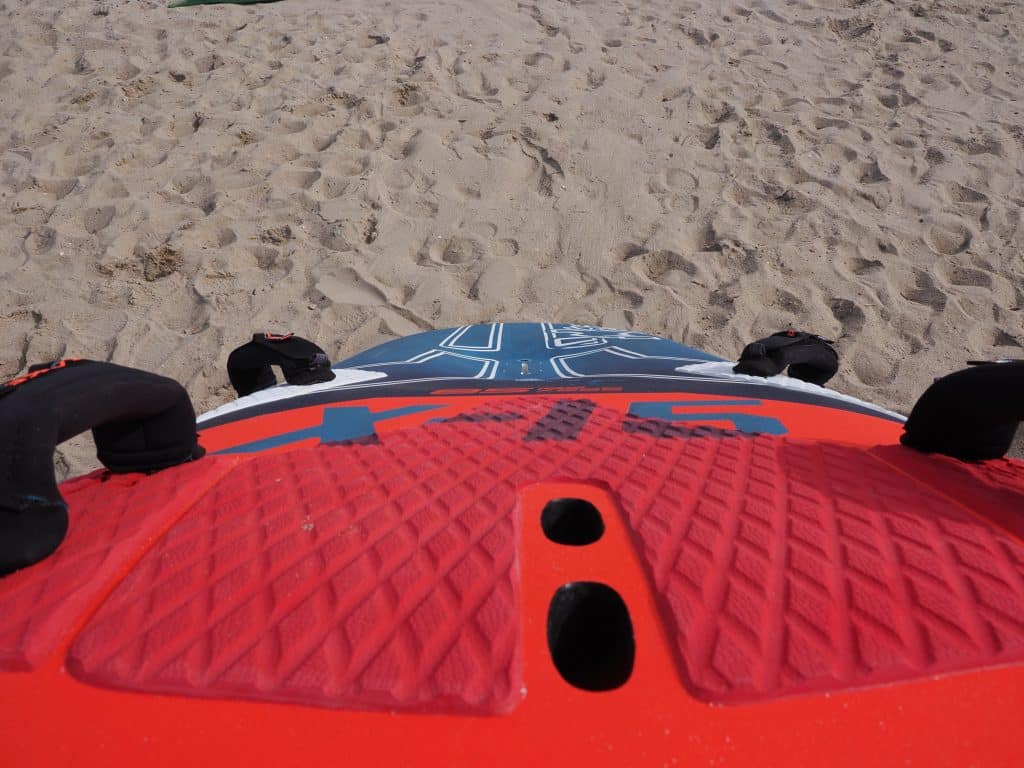
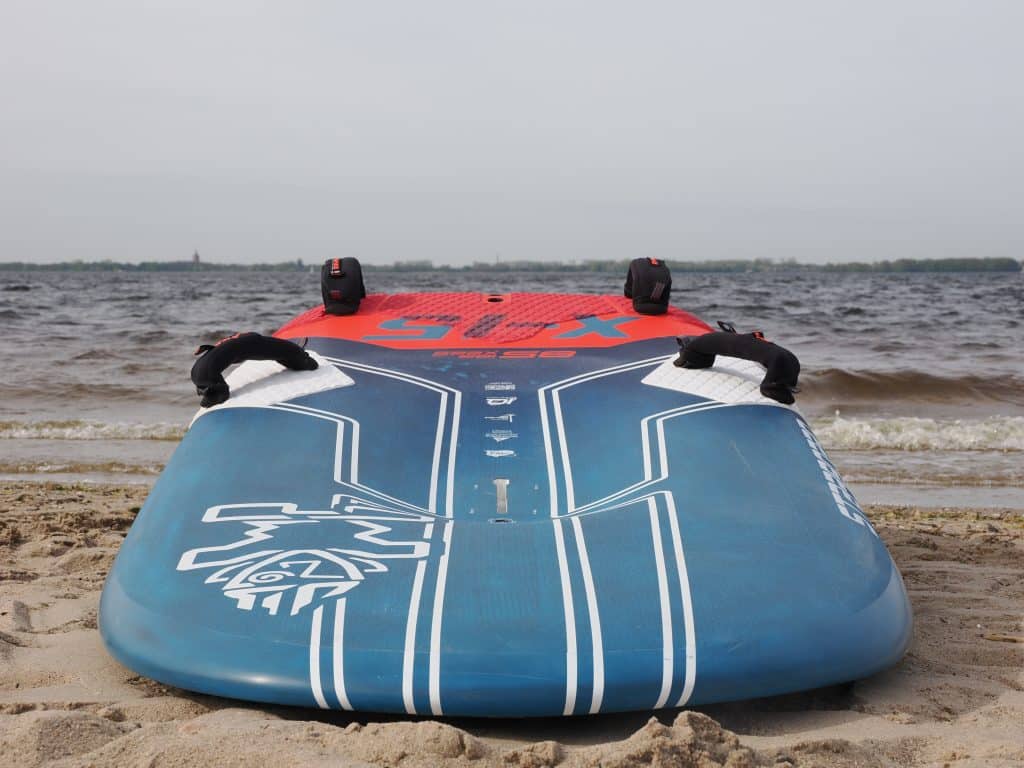
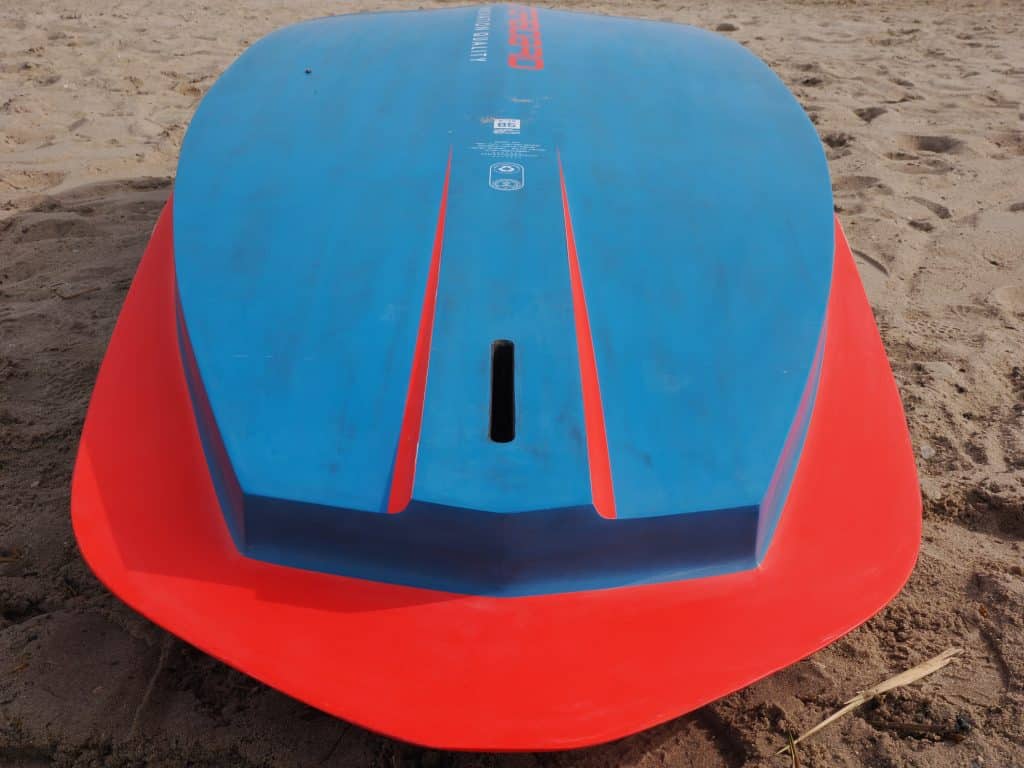
Future Fly: A Brief Introduction
Just a short introduction to the Future Fly brand. Arnon Dagan is the man behind this brand. In addition to being a former PWA competitive surfer, he was also a top shaper at the biggest windsurfing brands. Arnon’s ambition is to use his knowledge and experience to build the very best boards. The construction of the boards is also different. The Flying Camel has stronger carbon incorporated, which is stiffer and less vulnerable. In addition, stringers have been incorporated in various places that provide extra stiffness and extra strength (in places where this is needed). According to Future Fly, the tolerance of the production is also smaller compared to other major brands. That explains the extra cost of the Future Fly boards.
This still relatively small brand has an absolute topper as a team rider with Amado Vrieswijk. Armado won the PWA event in Sylt and Japan in 2023 with the Flying Camel. With that, Amado finished just behind Matteo in 2nd place overall. This experience has been translated into a new model, the Flying Camel 160.
Future Fly Flying Camel 160 focuses on control through a different approach
The Flying Camel 160 is a versatile board. According to Future Fly, you can sail up to 10 m2 on this. Based on our experiences, we think that sizes from 5.0m2 to 8.0m2 fit best with this board. What really stands out is how light the Flying Camel 160 is. On paper, this board should be about 1/2 kilo lighter than the X-15. But this is definitely more. We weighed both boards and the Future Fly is over 1 kilo lighter than the Starboard X-15 85.
The Future Fly Flying Camel 160 is less extreme shaping compared to the Starboard X-15. In fact, the deck of the board is almost flat. The nose is relatively narrow and the board widens equally towards the back. According to Future Fly, the relatively narrow nose and relatively wide rear would provide extra stability during high-speed foiling. In the bottom shape, we also see a V shape at the front, which should prevent the board from sticking to the water during touch downs. At the back, the board is also less extreme. Only fairly simple cut outs that should ensure an early take off.
The mast track is also sunk a bit deeper into the board. About 2 cm. And compared to most slalom foil boards, the mast track is about 3 cm further back. The same goes for the front and rear foot straps as well. Both the front and rear foot straps can be placed slightly inwards by a double row of foot strap plugs for more control or more free-racing.
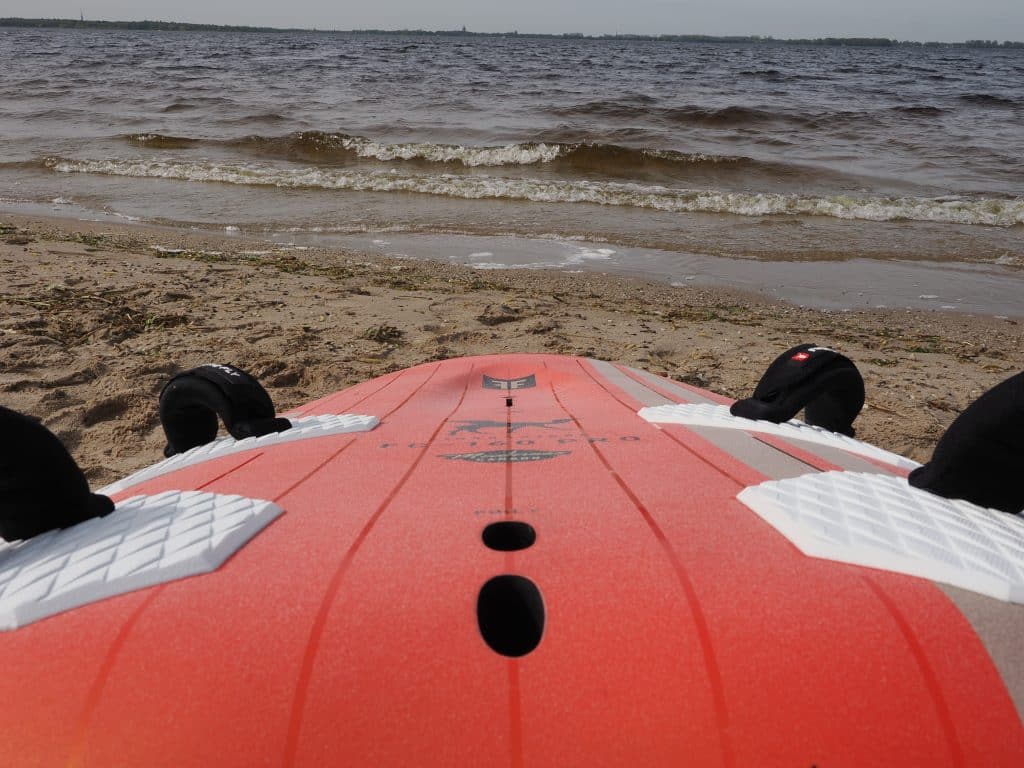
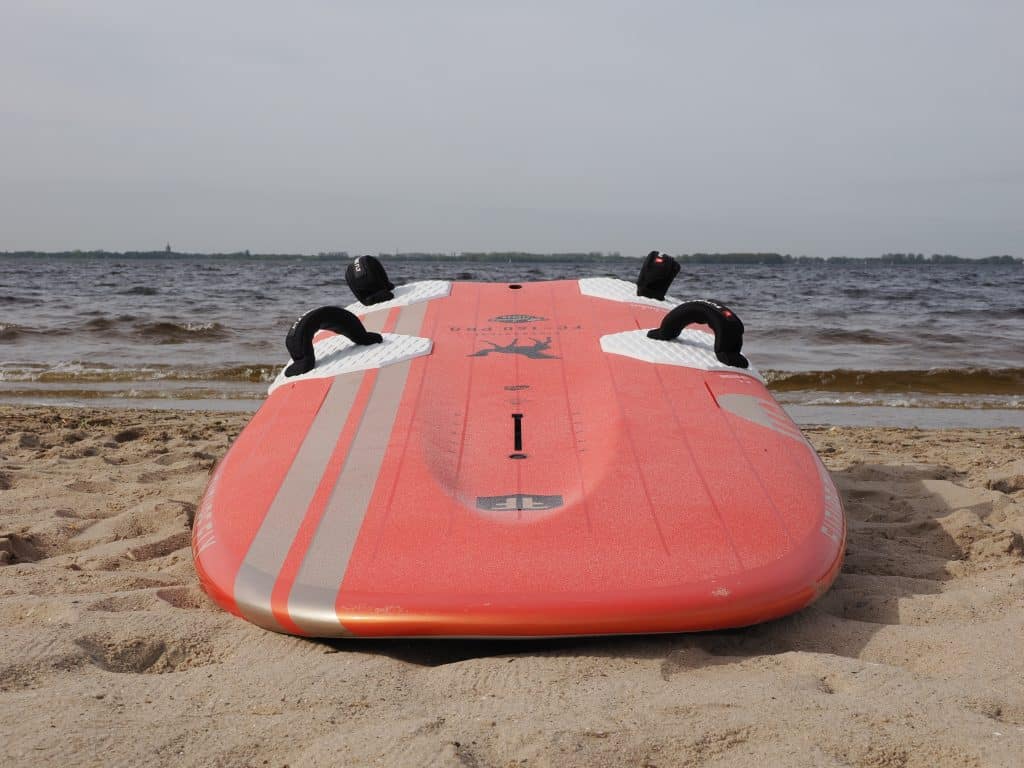
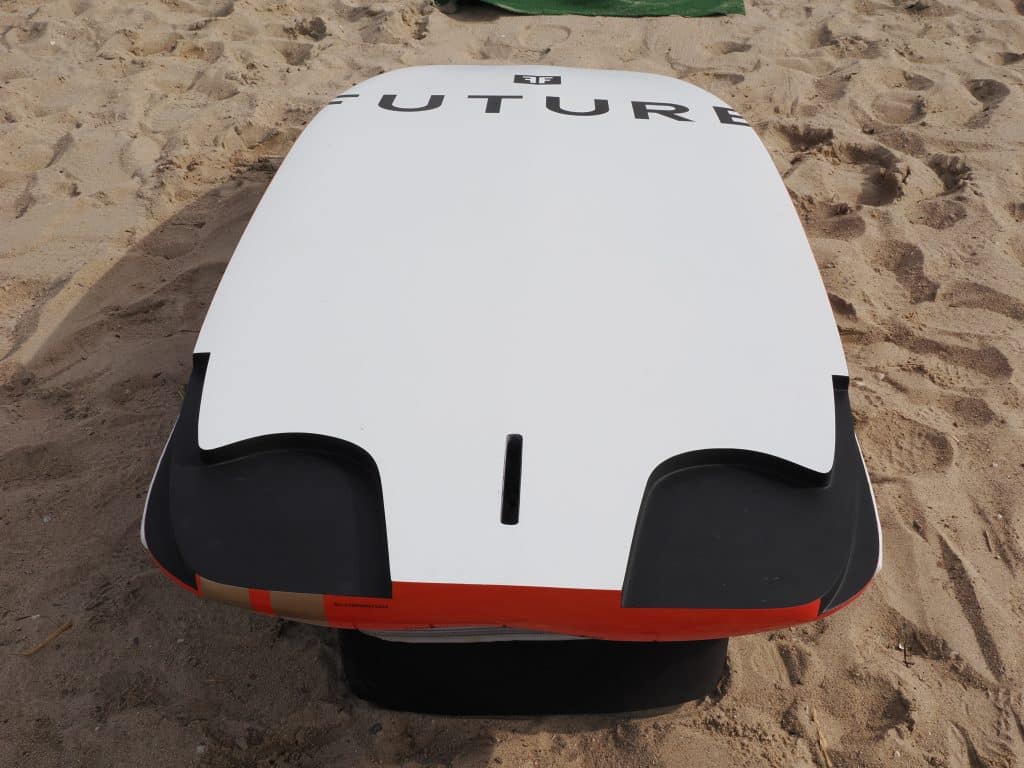
The saw in the carbon mast
We run into a problem with the placement of the foil! Like most foil masts, the foil mast of the F4 Foils 101 has a straight top. These masts fit perfectly into the foil boxes that most brands use. However, Future Fly uses a deep tuttle foil box. This box is sloping at the top. As a result, the box is not deep enough to place a foil mast with a rectangular base.
So there is no other option than to saw the base diagonally to get the mast to fit in the box. That is of course sour to have to put the saw in your expensive carbon mast (Note: Starboard has a ‘cut line’ on the base so you know where to cut the base).
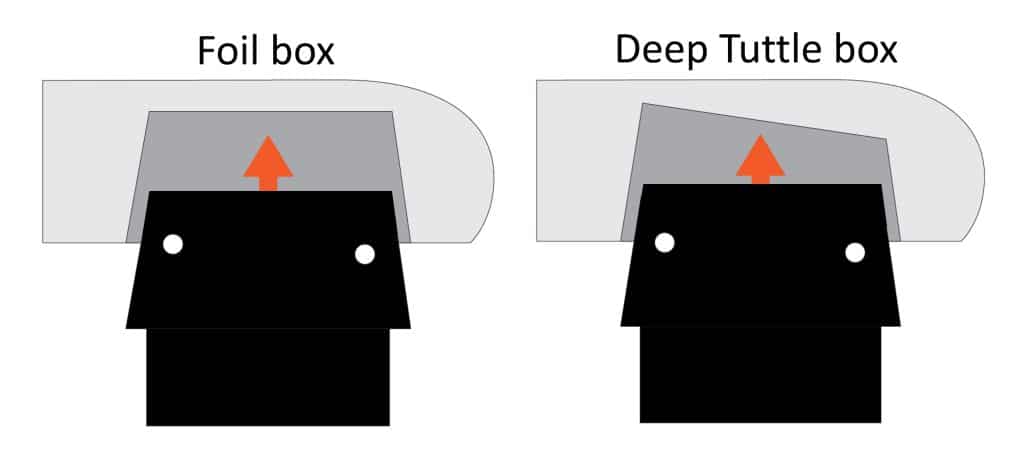
Differences between Flying Camel 160 and X-15 85 clearly noticeable
After the thorough inspection on the shore, quickly onto the water. With about 10 to 14 knots we start with a light weather session. With the Severne HG6 8.0 m2 and F4 Foils Slalom foil with 560 cm2 front wing and 190 cm2 back wing.
We start with the Flying Camel 160 and immediately notice how easy this board is to pump and how easy it is to get on the foil. Clearly easier than the X-15. This is despite the lower volume of the Flying Camel. We think this is because both the mast track and the foot straps are further back. The significantly lower weight will also contribute to this. As a result, you have less pressure on the nose, making it easier for the board to glide over the water.
On the foil, the Flying Camel 160 feels very stable and balanced. With this set up we are very relaxed. With a gust of wind, we also notice how easily the set accelerates. It just stands out! The board quickly feels familiar, which means that we quickly have the confidence to push and let the board run nice and downwind. Even now we notice that we are very ‘controlled’ on the board. We experience a lot of control, even when there is a big gust. This is because we stand slightly differently on the board due to the different configuration of the foot strap positions. It’s as if we can handle just a little more power than on the Starboard X-15.
With about 12 knots it is very relaxed cruising with this set up. With gusty winds, the nose of this board is also pushed down by the sail, but it seems like we have more time to correct it. We think this is mainly due to the fact that the mast track and the foot straps are relatively far back and the nose of the board is very light.
Also a next session with gusts of wind well through 16 knots (with the 8.0m2 and 7.0m2) we still experience the same control as during the light wind session. Gybing on this board is extremely easy. Even with little wind it is easy to keep enough speed to get on the foil. It feels very light.
If we then switch to the X-15 85, we feel a little higher (due to slightly thicker rear). With little wind, this gives the feeling of having just a little more power. At the same time, it also feels a little less stable. It is as if the board has a tendency to roll along its longitudinal axis. It’s just a matter of getting used to it and adapting your technique. In these light wind conditions we have the feeling that we have just a little more power than on Flying Camel. However, it does require more concentration and technique to convert this into extra speed.
If the wind blows a bit harder or we throw the board downwind, we experience a little less control than on the Flying Camel and it demands more of our technique. The board feels a little more nervous and we have the feeling that we are foiling at the limit (of our ability or our technique). The reactions of the board are just a bit more direct and extreme compared to the Flying Camel 160. The stronger the wind gets, the clearer this becomes. The X-15 requires 100% dedication from the rider to get the most out of the board.
Gybing also requires a little more dedication (and more aggressive style) than on the Flying Camel. You have to drive the X-15 just a little shorter and more aggressively through the corner to keep enough speed. Ideal, of course, if you have to go around a buoy for a short time to keep the gap closed for your competitor. But it does require more of your technical skills (and guts) compared to the Flying Camel.
Flying Camel and X-15 are boards for small foil set up
What both boards have in common is that they perform best with a foil setup with small wings. With the old X-15 we regularly foiled with a 620 cm2 front wing or even with a 720 cm2. With these boards, a 620 cm2 front wing is quickly too big. If you are considering purchasing one of these boards, keep in mind that on average you have to foil with smaller wings to get the most out of these boards. This in combination with fuselages of up to 105 cm. Although we noticed that on both boards a fuselage of 105 cm also feels overpowered quickly. Fussels of about 100 cm long are ideal.
What do you prefer?
Both boards are of course very evenly matched when it comes to performance. The way in which this is done is very different. It is important to think about what your own style of foiling is and which board you know how to get the most out of. We list the differences for you:
Future Fly Flying Camel 160
- Extremely easy to get on the foil
- Feels stable with plenty of control
- Gybing is very easy
- Also suitable for relaxed cruising
- Also suitable for performance freeracing
- With low wind a little less power
Starboard X-15 85
- A little more power with less wind
- Good technical skills needed
- Requires rider dedication
- Aggressive and short jibe
- High end slalom foiling
-
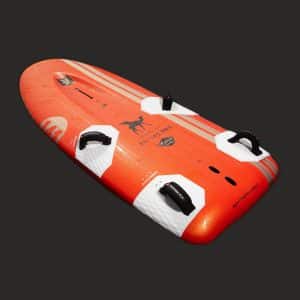
Future Fly Flying Camel
€3.399,00 – €3.499,00 incl. VAT Select options This product has multiple variants. The options may be chosen on the product page -
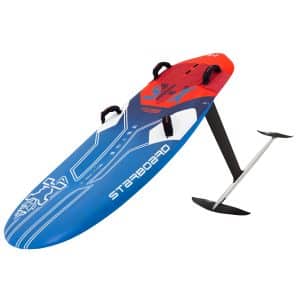
Starboard X-15 Foil Slalom 2024
€3.399,00 incl. VAT Select options This product has multiple variants. The options may be chosen on the product page
In detail, our set up of the Flying Camel and X-15
Foot band positions
For both boards, we use the inner positions for the rear foot straps. With more wind and downwind, this gives the most control. With little wind, we put our back foot a little more outwards (so a little out of the rear foot strap) to have just a little more power. On the Future Fly, we do leave the front foot strap in the outer position (on the Starboard, there is no choice).
On both boards we have the rear foot strap in the middle of the 3 plugs and the front foot strap we put in the front plug. As a result, we stand a little further apart with our legs out. We are then a little more stable and can better keep the height balance. In addition, we can more easily put more pressure on the foil when it goes faster. The disadvantage that we may arrive a little later on the foil (we are a little more forward) we take for granted.
Mast foot position
On the Flying Camel we have the mast track about in the middle. The mast track is relatively far back. This position gives a nice balance between getting on the foil quickly and a good balance/stability during foiling. In this position, we also don’t have any problems with it dragging on the foot straps.
On the X-15 we move the mast track 2 cm backwards in relation to the middle position. As a result, the board becomes slightly less sensitive to gusts of wind. It also ensures that the lower body is less likely to touch the foot straps. Because the mast track is so deep, we regularly had it get stuck behind the rear foot straps, causing the board to become unbalanced. The mast track slightly backwards solved this for 80%.
Rake of the fuselage
On both board we foiled with a rake of between 3.0 and 3.5 degrees. With light winds (on inland waters) we also liked a rake of 2.5 to 3.0 degrees. Because of the smaller rake we got on the foil just a little easier.
Testing the Future Fly Flying Camel
Do you want to experience for yourself how the Flying Camel 160 foils? We have this board available in our test center to test out. Send us a message and we will be happy to schedule a test appointment with you.


